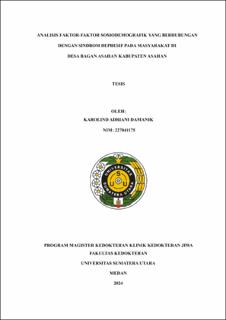| dc.description.abstract | Background: Data from the World Health Organization (WHO) indicate that, globally, approximately 3.8% of the world's population suffers from depression, including 5% of adults (4% of men and 6% of women) and 5.7% of adults over the age of 60. Meanwhile, data from Peltzer and Pengpid in 2018 reported the prevalence of depressive symptoms in Indonesia at around 21.7% in rural populations and 19% in populations in Sumatra. Mental health disorders, especially depression, have been on the rise globally. This is partly because mental health disorders are often considered a silent epidemic, particularly in rural areas. Structural and systemic conditions, including healthcare infrastructure, the number of healthcare professionals, and access to mental health services, may contribute to the state of mental health care.
Method: This study is an analytical multivariate logistic regression study with a predictive conceptual framework, using a cross sectional approach. The study involved 366 community samples from Bagan Asahan Village, analyzing the relationship between several independent variables and the dependent variable using the PHQ 9 instrument.
Results: The study found a depressive syndrome prevalence of 36.1% in the population of Bagan Asahan Village. Bivariate analysis showed significant relationships between employment status (p=0.030), income level (p<0.001), and education level (p=0.018) with depressive syndrome. Multivariate analysis revealed a significant association between income level (OR=2.55, p<0.001) and education level (OR=4.956, p=0.035) with depressive syndrome.
Conclusion: The sociodemographic factors associated with depressive syndrome are income level and education level. In the future, further research on the association between sociodemographic factors and depressive syndrome with a better study design is needed to demonstrate causality. | en_US |


